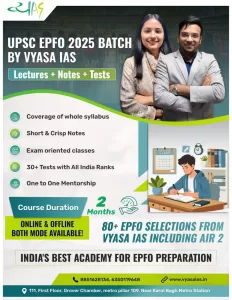
General Science UPSC EPFO APFC PYQ Topic list by Vyasa IAS
2023 APFC
- Effluents released from industries and its impact on PH value of water
- Soaps and detergents and their compounds – sodium stearate, sodium palmate, sodium oleate
- Three layers of human eyeball
- Oxidation and reduction reactions
- Plant morphology – root modifications (tap roots, climbing roots, fibrous roots, prop roots)
- Optics – lenses and combination of convex and concave lenses
- Mechanics – laws of motion (kinetic, potential and momentum) and collisions (elastic and inelastic)
- Physics problems related to acceleration
- Optics – convex and concave mirror – formation of real/virtual and inverted/erect images
- Causes of Ocean acidification
2016 APFC
- Application of Newton third law – (Newton laws of motion)
- Thermodynamics – heat and temperature concepts
- Magnetism – diamagnetic materials
- Solubility of gases in water
- Chemicals- formula, uses, components (Bleaching powder)
- Diseases and vectors – Chikungunya
- Bio remediation technology and its uses
- Microbiology (Bacteria, viruses, Lichens) and their impact on humans and historical monuments
- Plant and animal classification (study unique plants and animals)
- Food preservation and storage techniques (using neem leaves for preservation)
2015 APFC
- Nano technology
- Cloud computing technology
- Cellular technology and its evolution in different generations – 2G. 3G, 4G, 5G
- GPS technology
- Sinusoidal transverse wave
- Concepts in physics – force, work, friction, distance and its applications
- Causes of acid rain
- DNA fingerprinting technology
- Pollution concepts – particulate matter, suspended particulate matter
- Genetically engineered crops – advantages
- Carbon footprint terminology
- Green revolution- facts, advantages, disadvantages
2002 APFC
- Electronics and electricity – Devices to convert AC to DC (Transformer, Rectifier, Alternator, Condenser)
- Types of chemical reaction – Photochemical, Exothermic, Physical, Endothermic reactions
- Chemical compounds – examples
- Diseases – Stockholm syndrome
- Human physiology – carbohydrates are stored in body as
- Bacterial and viral diseases
- Antimicrobial substances and applications – Antibiotics
- Mechanics – Laws of motion, Inertia, Work and energy concepts, problems and applications
- Work, energy, acceleration, force concepts and applications, Newton laws of motion and inertia
2004 APFC
- States of matter, properties of solids – Glass, Teflon, Mercury
- Human physiology – effects on circulatory system and human body I high altitudes
- Air pollution check – on carbon monoxide
- Optics and light rays – Polarisation, refraction, reflection, Total internal reflection
- Gravitation and its variation with height and depth
- Vitamins and chemical names – vitamin A, B, C, D etc
- Vitamin deficiency, diseases and disorders
- Elements found/not found in human beings
- Uses of chemical compounds – Glycerol, Phenol, Antiseptics, Disinfectants, Alcohol
2012 APFC
- Biome – impacts on biome
- Body mass Index concept and formula
- Sources of energy – geothermal energy and power production
- Metals and alloys – Gun metal
- Electrical resistance of materials – Conductors, semiconductors, super conductors, super semiconductor
- Metals and alloys – properties, uses in electricity
2023 EO/AO
- DNA – characteristics, properties
- Human physiology – tissues (spongy tissue)
- Elements and their nature – how they react to temperature (boiling point, cooling point), elements like lithium, Sodium, Potassium, Rubidium
- Chemical compounds – Hydrogen, its nature, components, solubility
- Surface area and volume of ice – how it changes when divided into small pieces
- Physics problems related to bulb – power and current
- Problems related to current in wire
- Chemical compounds and change in their colour on heating- copper sulphate pentahydrate
- Tartaric acid
- Examples of chemical change
- Large language models and their uses
- Types of emissions and their scope – Scope 1, 2, 3 Emissions
2021 EO/AO
- Female reproductive organ
- Plant kingdom – Amphibian of plant kingdom
- Consequences of Deforestation
- Matched and mismatched chromosomes in Males and females
- Vaccine derived from which word
- Images formed by eyes
- Electromagnetic waves – wavelength and frequency
- Size of hydrogen atom
- Force – positive force and negative force
- Electromagnetism concepts – Magnetisation, Polarisation, Photoionization Circularization
- Changes in pH of substances – NaHCO3, NH4CL, Na2CO3, NaCl
- Scattering of light – substances that do not scatter light on adding water
- Oxidation and reduction reactions – substances that do not get reduced by metallic zinc
- Discoveries – who discovered proton
- Physics problems – related to calculation of moles in chemical equations
UPSC EPFO APFC COMPUTER PYQs Topiclist: Link
